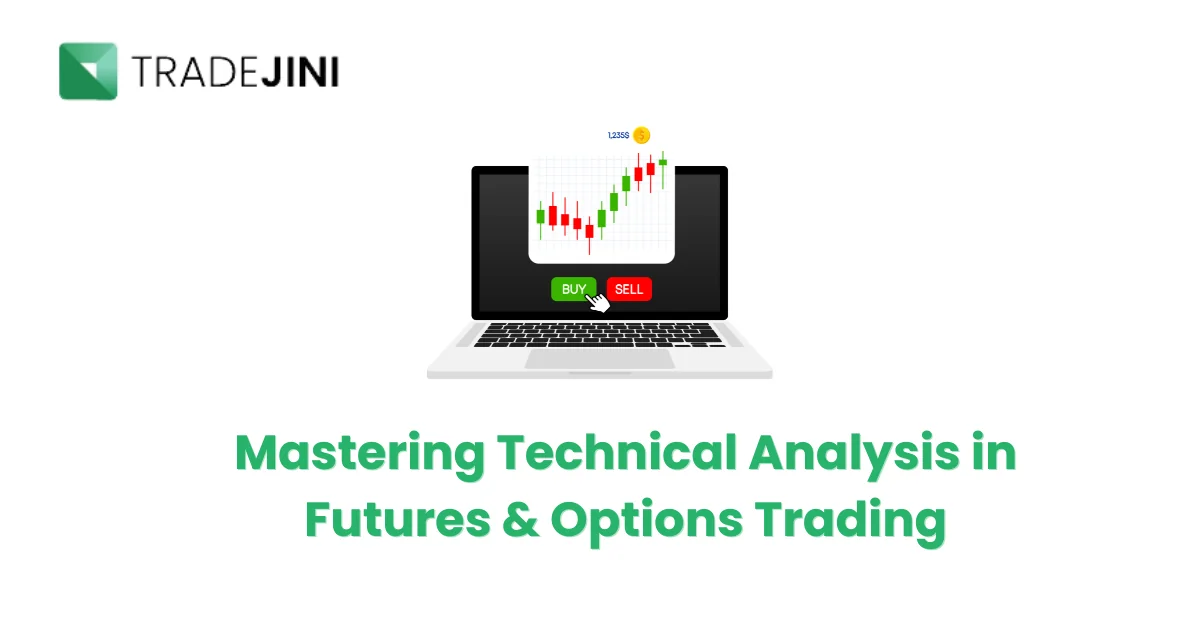Basics of Futures and Options Trading
Let's simplify Futures and Options with easy examples.
Futures: Imagine you're buying a car. You agree to buy it at a fixed price in three months. No matter if the car's market price goes up or down, you'll pay the price you agreed on. This is like a futures contract. It's a deal to buy or sell something at a fixed price in the future. Traders use futures to fix their costs or to bet on how prices will change.
Options: Now think of a movie ticket. You pay a small amount to hold a ticket for a movie that's coming out next month. You can choose to buy the ticket at the original price later, or not buy it at all. This is like an option. It gives you the right to buy (call option) or sell (put option) something at a certain price in the future, but you don't have to if you don't want to.

Knowing these tools is important because they're the foundation for using technical analysis in F&O trading.
Leverage and Its Role in F&O
Both Futures and Options are leveraged instruments. This means you can control a big amount of assets with a small amount of money. It's like having a stronger effect with less effort. Leverage increases both potential profits and losses, so knowing and managing risks is important.
Pillars of Technical Analysis
Technical analysis is a method which is used to evaluate and forecast future price trends in the market, mainly by analyzing charts. It rests on three main principles:
- Market Action Discounts Everything: This key idea suggests that all available information is already factored into prices. Essentially, the current price reflects the collective knowledge and expectations of all market participants.
- Prices Move in Trends: At the heart of technical analysis is the belief that prices follow specific patterns and trends. Identifying these trends early is crucial for successful trading.
- History Tends to Repeat Itself: Market behavior is consistently influenced by market psychology. As a result, certain patterns and trends reappear over time.

Chart Types and Their Interpretation
- Line Charts: The most basic form, these charts connect closing prices with a line. They offer a straightforward view of the trend over a period.
- Bar Charts: These charts show more details (open, high, low, and close prices). Each bar represents a trading period and provides insight into market sentiment.
- Candlestick Charts: With origins in Japan, these charts are akin to bar charts but use colors to show if the closing price was higher or lower than the opening price. They are especially valued for vividly representing market psychology and sentiment. Example: A candlestick with a long lower shadow and a short body, known as a 'hammer', indicates that despite strong selling pressure, buyers were able to push the price back up near the opening level, hinting at a potential bullish reversal.
Trend Analysis
- Uptrends: These are identified by a series of higher highs and higher lows. In such scenarios, traders often look for buying opportunities.
- Downtrends: Characterized by lower highs and lower lows, downtrends suggest possible short-selling opportunities or signals to exit long positions. Example: A stock consistently achieving higher peaks and troughs over a period exemplifies an uptrend, reflecting bullish sentiment among traders.

Support and Resistance
- Support: This refers to a price level where a falling trend is likely to pause due to concentrated demand. It acts like a floor, causing the price to bounce back up.
- Resistance: The opposite of support, resistance is a level where price stops rising and might reverse due to selling pressure. Example: If a stock repeatedly struggles to exceed Rs 100, that price serves as a resistance level. Conversely, if it seldom drops below Rs 80, this is its support level.
In summary, technical analysis in F&O trading relies heavily on understanding these principles and interpreting various chart types to identify market trends, support and resistance levels, guiding traders in making informed decisions.
Technical Indicators and Tools
Technical indicators are vital tools for traders, providing insights into market trends and aiding in the prediction of future price movements. Let's delve deeper into some of the most commonly used indicators in technical analysis.
Moving Averages (MAs)
- Simple Moving Average (SMA): This indicator calculates the average price of a security over a specified number of days. By doing so, it helps smooth out price fluctuations and provides a clearer view of the overall trend direction.
Example: A 50-day SMA is calculated by taking the average closing price of a security over the past 50 days. This average helps identify whether the general trend over this period is upwards or downwards.
- Exponential Moving Average (EMA): Similar to the SMA, the EMA also calculates an average price over a certain period. However, it gives more weight to recent prices, thus making it more responsive to new market information. This feature makes the EMA particularly useful for traders looking to respond quickly to recent price changes.

Example: A 20-day EMA will be more sensitive to price movements than a 20-day SMA. For traders focusing on short-term strategies, this sensitivity can provide early signals of trend changes.
Momentum Indicators
These indicators are designed to identify the speed or strength of a price movement, which can be crucial in determining entry and exit points.
- Relative Strength Index (RSI): This tool measures the magnitude of recent price changes to evaluate if a security is in overbought or oversold conditions. The RSI is scaled from 0 to 100, providing a quantifiable measure of market conditions.
Example: An RSI reading above 70 is typically considered to indicate that a security is overbought, suggesting a potential price pullback. Conversely, an RSI below 30 often signals oversold conditions, indicating a possible price increase.
- Moving Average Convergence Divergence (MACD): The MACD compares two EMAs of a security to determine the momentum. The main MACD line is the difference between the 26-day and 12-day EMAs, and a signal line (the 9-day EMA of the MACD) is plotted alongside to identify potential buy or sell signals.
Example: When the MACD line crosses above the signal line, it's considered a bullish signal, indicating a potential upward price movement. A crossover below the signal line is seen as bearish, hinting at a potential downward trend.
Volume Indicators
- Volume: This simply measures the number of shares or contracts traded in a security or market during a given period. Volume analysis can provide insights into the strength or weakness of a price trend.
Example: A significant increase in volume during a market uptrend confirms the strength of the bullish trend (indicating strong buyer interest). In contrast, high volume during a market decline might suggest panic selling or strong selling pressure, which is bearish.
Chart Patterns
Recognizing patterns on charts is a key part of technical analysis, as these patterns can offer predictive insights into future price movements.
- Head and Shoulders: This pattern is often indicative of trend reversals. It features a peak (the head) between two lower peaks (the shoulders), resembling the outline of a person's head and shoulders.
Example: In an uptrend, the appearance of a head and shoulders pattern can signal that the uptrend is nearing its end and that a reversal to a downtrend may be imminent.
- Double Tops and Bottoms: These patterns occur when prices form two distinct peaks (tops) or troughs (bottoms) at roughly the same level. They are indicative of a struggle between buyers and sellers to control price direction.

Example: A double top pattern seen after a strong uptrend suggests that the upward momentum is waning and that a reversal to a downtrend may follow. Conversely, a double bottom pattern after a downtrend indicates a potential shift to an upward trend.
Applying Technical Analysis to F&O Trading
Applying technical analysis to Futures and Options (F&O) trading involves using various strategies and tools to make informed decisions. These strategies are designed to capitalize on market movements and mitigate risks.
Strategies for Futures Trading
- Trend Following: This strategy involves using moving averages or trendlines to identify the market's direction and then taking positions that align with this trend. It is based on the principle that markets tend to move in trends, and identifying these trends can lead to profitable trading opportunities.
Example: If a trader observes that the price of a future crosses above a key moving average, such as the 50-day moving average, it might indicate an upward trend. In this case, buying the future could be a strategic move, expecting the trend to continue.
- Breakout Trading: This approach focuses on entering a trade when the price moves outside a defined price range, such as breaking through levels of support or resistance. Breakout trading aims to capture the significant moves that often follow when a price breaks out of a consolidation range.
Example: If the price of a future breaks above a known resistance level, a trader might interpret this as the start of a new uptrend and decide to buy the future, anticipating further price increases.
Strategies for Options Trading
- Buying Calls and Puts: This strategy is based on using bullish or bearish signals from technical indicators to decide when to buy call or put options. Call options are bought when a bullish trend is anticipated, while put options are purchased when a bearish trend is expected.
Example: A trader might buy a call option when a bullish reversal pattern, such as a double bottom, is identified in the market, indicating an expected upward move in price.
- Selling Covered Calls: Suitable for a flat or slightly bullish market, this strategy involves owning a stock and selling call options at a higher strike price. It allows the trader to generate income through the premiums received from selling the calls.

Example: If a trader owns a stock and believes the market will remain stable or grow slightly, they might sell call options at a strike price above the current market price to earn premium income.
- Protective Puts: This involves buying a put option to hedge against a potential decline in the value of a stock or future that a trader holds. It's a way to limit downside risk while maintaining the potential for upside.
Example: If a trader holds a long position in a future and is concerned about potential short-term downside, buying a put option can provide a safety net, limiting the loss if the price falls.
Risk Management
Effective risk management is key in F&O trading to protect against significant losses.
- Stop-Loss Orders: These are pre-set orders to sell a security when it reaches a certain price, effectively capping the potential loss on a position.
Example: A trader might set a stop-loss order at a price slightly below the purchase price or a key support level to automatically exit the position and limit losses if the market moves unfavorably.
- Position Sizing: This involves adjusting the size of a trading position based on the level of risk associated with the trade. It's crucial for managing the overall risk exposure of a portfolio.
Example: A trader might invest only a small percentage of their total capital in a high-risk trade, while allocating more capital to trades with lower perceived risk.
In summary, applying technical analysis in F&O trading requires a blend of strategic planning, understanding of market indicators and patterns, and diligent risk management. These strategies enable traders to make more informed decisions, capitalize on market movements, and protect their investments from undue risk.

Advanced Concepts in Technical Analysis
In this section, we will talk about some complex trading theories and tools that experienced traders use to make their trading strategies better.
Fibonacci Retracements and Extensions
- Overview: These tools are based on the Fibonacci number sequence and are used to identify potential reversal levels in the price of a security.
- How to Use: Fibonacci retracements are created by selecting two significant points (typically a major high and low) on a stock chart and dividing the vertical distance by the key Fibonacci ratios (23.6%, 38.2%, 50%, 61.8%, and 100%). These ratios represent potential support or resistance levels.
Example: After a stock experiences a significant price rise or fall, traders observe how it retraces. If it retraces to, say, the 61.8% Fibonacci level and then resumes its original trend, this level may act as a strong support (in an uptrend) or resistance (in a downtrend).
Elliot Wave Theory in F&O Trading
- Theory: Proposed by Ralph Nelson Elliott, this theory suggests that financial markets move in predictable, repetitive wave patterns, which are influenced by investor psychology and external factors.
- Application: Traders apply this theory to decipher 'waves' in market price movements, helping them to anticipate future market trends. The theory is often used to interpret market cycles and forecast future price movements.
Example: In a bullish market scenario, the Elliott Wave pattern typically exhibits a three-wave upward trend (indicative of market optimism), followed by a two-wave correction (reflecting market retracement or consolidation).
Algorithmic Trading and Technical Analysis
- Definition: This involves the use of computer algorithms to execute trading strategies at high speeds and volumes, often beyond the capability of manual trading.
- Integration with Technical Analysis: Traders can incorporate technical analysis into algorithmic trading by programming algorithms based on specific technical indicators and chart patterns. These algorithms can automatically execute trades when certain conditions are met.

Example: An algorithm may be programmed to buy a futures contract when a specific technical condition is met, such as when the 50-day moving average crosses above the 200-day moving average. This crossover might be interpreted by the algorithm as a bullish signal, prompting an automated buy order.
In conclusion, advanced technical analysis encompasses a range of sophisticated tools and theories, from Fibonacci retracements to Elliott Wave Theory and algorithmic trading. These concepts allow traders to analyze markets at a deeper level, providing a more nuanced understanding of market movements and enabling more precise trading strategies in the F&O market.
Combining Fundamental and Technical Analysis
Although technical analysis is useful on its own, combining it with fundamental analysis can help traders get a fuller picture of the market.
Interplay of Fundamental and Technical Analysis
- Fundamental Analysis: This approach involves evaluating a company's financial health, the effectiveness of its management, conditions within its industry, and broader economic factors. Fundamental analysis is about understanding the intrinsic value of a security and its potential for growth or decline.
- Combining Approaches: A balanced strategy involves using fundamental analysis to determine 'what' to buy or sell (i.e., identifying securities with solid fundamentals or growth potential) and technical analysis to decide the 'when' (i.e., identifying the optimal timing for entering or exiting a position based on market trends and patterns).
Balancing Technical Signals with Market News and Events
- Market Events: External factors such as earnings reports, economic data releases, and geopolitical events can significantly influence market movements. These events can often lead to sudden and substantial changes in market sentiment and price action.
- Integrating Market Events: It is crucial for technical analysts to stay informed about these events. While technical analysis can provide indications based on historical data and patterns, real-world events can sometimes override these technical signals, leading to unexpected market movements.
Example: Consider a scenario where a company releases a strong earnings report that exceeds market expectations. This positive news might cause the company's stock price to surge, potentially breaking through established resistance levels in a way that technical analysis alone might not have predicted.
Staying Ahead of the Curve in Technical Analysis
Technical analysis is a dynamic field, and staying informed and adaptable is key to success in Futures and Options (F&O) trading.
Continual Learning and Adaptation in Technical Analysis
- Importance of Education: The financial markets are in constant flux, which means your understanding of technical analysis should evolve accordingly. Keeping your knowledge and skills up to date is essential in staying relevant and effective in your trading strategies.
- Sources for Learning: There are many resources available for continued learning. Books, online courses, webinars, and workshops conducted by experienced traders are invaluable for gaining insights and staying informed about the latest developments in technical analysis.
Utilizing Software and Tools for Technical Analysis
- Software and Platforms: Modern trading software and platforms offer advanced charting capabilities, a range of technical indicators, and back-testing features. These tools can significantly enhance your analysis and trading execution.
- Mobile Trading: The rise of mobile trading apps has made it easier to trade and analyze the markets on the go. These apps provide real-time trading capabilities and analytical tools, allowing you to make informed decisions anytime, anywhere.
Future Trends: AI and Machine Learning in Technical Analysis
- Artificial Intelligence (AI) and Machine Learning (ML): These emerging technologies are increasingly being used to analyze market data and identify trading opportunities. AI and ML can process and interpret vast amounts of market data more efficiently than traditional methods.
- Predictive Analytics: By using AI and ML, traders can benefit from predictive analytics, which can process large datasets to forecast market trends and offer personalized trading recommendations, potentially increasing the accuracy of trading decisions.
Conclusion
- Key Takeaways: Technical analysis is an indispensable tool in F&O trading. It requires an understanding of market trends, the application of various technical indicators, and the integration of these elements into comprehensive trading strategies.
- Final Thoughts: While technical analysis is a powerful tool, it's important to remember that no method guarantees success in trading. Effective risk management and a balanced approach that combines technical and fundamental analysis are crucial for long-term success.



